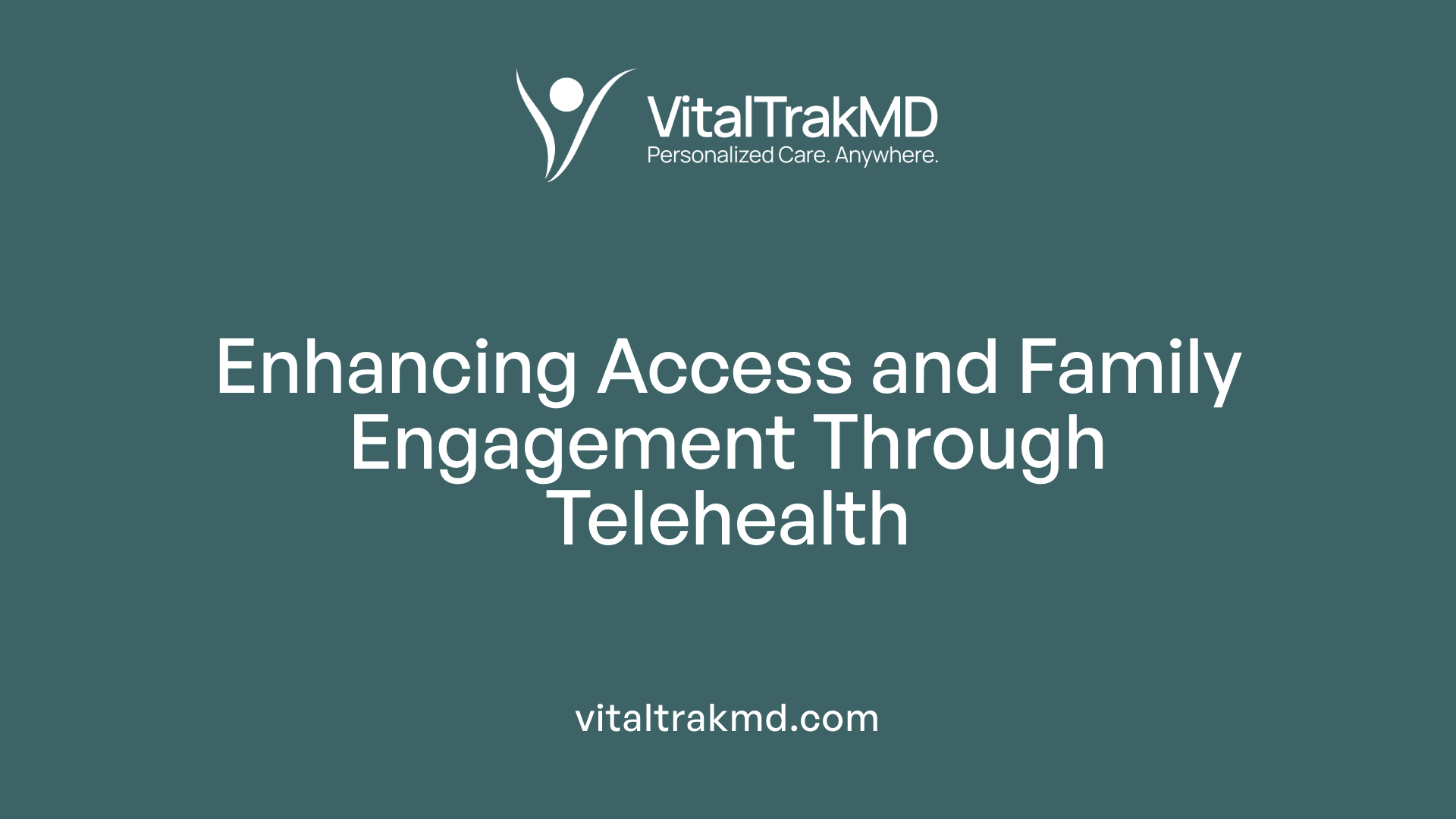How Hybrid Healthcare Promotes Open Family Involvement

Introduction to Hybrid Healthcare and Family Engagement
The hybrid care model (HCM), which emerged as a response to the challenges posed by the SARS-CoV-2 pandemic, combines telehealth, in-person consultations, and health education to provide comprehensive care for chronic disease management. As healthcare continues to evolve, hybrid healthcare is proving essential not only in increasing access and continuity of care but also in promoting open, active involvement of families. This article explores how hybrid healthcare fosters family engagement, supports wellness and weight management, and transforms care programs for improved outcomes.
Understanding the Hybrid Care Model in Chronic Disease Management

What is the Hybrid Care Model and What Are Its Main Components?
The Hybrid Care Model (HCM) merges telehealth consultations, in-person visits, and health education to provide comprehensive management for patients with chronic, non-communicable diseases.
This approach includes patient training on monitoring devices such as glucometers and blood pressure monitors, scheduled telehealth follow-ups via video or phone, and face-to-face consultations delivering physical exams, diagnostics, and therapeutic adjustments across multiple specialties including medicine, nutrition, and psychology.
Which Conditions Does the Hybrid Care Model Target?
HCM is designed to support patients managing conditions like overweight, obesity, pre-diabetes, diabetes, and hypertension. Its main goals involve improving cardiometabolic control and reducing unscheduled appointments, emergency room visits, and hospitalizations.
How Does the Model Integrate Telehealth and In-Person Care?
Telehealth in HCM comprises structured and empathetic consultations standardized with review of medical records and documentation in electronic health systems. This virtual component ensures continuous monitoring and care, especially critical during pandemic situations.
In-person care complements telehealth through physical exams and therapeutic modifications, allowing specialists from various fields to address complex patient needs.
What Role Do Care Programs Play in Supporting Overall Health and Wellness?
Care programs like HCM offer personalized and structured support that empowers patients to manage chronic diseases effectively. Incorporating self-care and education promotes disease prevention and healthier lifestyles outside traditional clinical environments.
These programs improve healthcare efficiency by preventing unnecessary hospital visits and fostering early interventions, emphasizing a people-centered and equitable approach to wellness.
Together, the hybrid model creates a robust framework that bridges virtual and face-to-face healthcare, enhancing access, adherence, and outcomes for chronic disease patients.
The Role of Telehealth in Enhancing Access and Family Participation

Telehealth Consultations and Family Involvement
Telehealth consultations form a vital part of hybrid care models, particularly in managing chronic non-communicable diseases. These virtual visits promote family involvement by allowing easier scheduling and participation from multiple family members. Family engagement is crucial in supporting therapeutic adherence and fostering healthy lifestyle habits, especially in pediatric and adult chronic care.
Scheduled Calls and Video Visits
The telehealth component of hybrid care relies on structured, scheduled phone calls and video consultations. These interactions are standardized to include thorough reviews of previous medical records, empathetic patient interviews, and detailed documentation within electronic medical records. Such systematic approaches help ensure continuity of care, prompt attention to patient concerns, and active family participation.
Remote Monitoring Tools
Remote patient monitoring plays a complementary role in telehealth. Patients receive training to use devices like glucometers, blood pressure monitors, pulse oximeters, and scales. Data collected remotely enables healthcare providers to track patients’ cardiometabolic parameters continuously and make timely adjustments during telehealth or in-person visits. This technology not only improves access but also empowers families to engage actively in disease self-management and health education.
These telehealth strategies combined enhance accessibility, promote family-centered care, and contribute to improved health outcomes, all while reducing the need for unscheduled appointments and hospital visits.
In-Person Consultations: Maintaining the Human Touch in Hybrid Care
How are physical exams and diagnostics integrated into hybrid care?
Despite the emphasis on telehealth, in-person consultations remain a vital component of the hybrid care model (HCM). At clinics such as Centro Médico ABC in Mexico, patients receive thorough physical exams and diagnostic testing during their face-to-face visits. These sessions allow clinicians to track tangible health parameters that are difficult to assess remotely, ensuring individualized and precise evaluation of chronic conditions like obesity, diabetes, and hypertension.
What role do therapeutic adjustments play in the hybrid care model?
In-person visits enable healthcare providers to make necessary therapeutic adjustments. This can include modifying medications, introducing new treatment approaches, or recommending specialized interventions tailored to the patient's evolving health status. Such flexibility empowers providers to respond swiftly to clinical findings and patient feedback, thereby enhancing treatment effectiveness.
How does a multidisciplinary team support hybrid care?
A distinctive feature of the hybrid model is its multidisciplinary team approach. Beyond physicians, professionals from nutrition, psychology, nursing, dentistry, and pharmacy collaborate to address the diverse needs of patients managing non-communicable diseases. Nutritionists provide dietary counseling, psychologists support emotional and behavioral health, and nurses oversee patient education and follow-up. This holistic approach ensures comprehensive care that extends beyond purely medical management.
By combining the irreplaceable benefits of physical presence with telehealth convenience, the hybrid care model strikes a balance that fosters strong patient-provider relationships while maintaining clinical rigor in managing chronic health conditions.
Health Education and Chronic Disease Self-Management at Home
How are patients educated on self-monitoring tools in the hybrid care model?
Patients participating in the hybrid care model receive comprehensive training on using various self-monitoring devices critical for managing chronic conditions at home. These devices include glucometers for blood sugar tracking, blood pressure monitors, pulse oximeters, and scales. Training ensures that patients are confident and accurate in recording their health measurements, which are then monitored via follow-up telehealth or in-person consultations.
What educational topics are covered regarding obesity prevention and treatment?
The program integrates focused education on obesity prevention and treatment. Patients attend tailored health education sessions covering lifestyle modifications, nutritional guidance, and strategies to maintain a healthy weight. These sessions are designed to empower individuals with the knowledge and motivation needed to combat overweight and obesity, common risk factors for cardiometabolic diseases.
How are emotional management sessions incorporated into patient care?
Recognizing the psychological challenges linked to chronic disease management, the hybrid care approach includes emotional management sessions. These sessions aim to provide psychological support and develop coping strategies to help patients manage stress, anxiety, and other factors that can influence disease progression and adherence to treatment plans.
By combining hands-on patient training, obesity-related education, and emotional support, the hybrid care model ensures a holistic approach to chronic disease self-management at home. This multifaceted education fosters patient empowerment, encourages sustained healthy behaviors, and contributes to improved cardiometabolic outcomes.
How Hybrid Care Improves Wellness Program Effectiveness
What are the key components of effective wellness programs?
Effective wellness programs combine multiple elements to address the diverse health needs of participants. They include promoting physical activity through structured exercise initiatives and providing tailored nutritional guidance to encourage healthier eating habits. Stress management techniques such as mindfulness practices, counseling services, and emotional support are essential to help individuals cope with daily challenges. Regular health screenings and assessments allow early identification of health concerns, facilitating timely intervention. Educational workshops and behavioral support further empower participants to make sustainable lifestyle changes, fostering a health-conscious environment and continuous engagement.
Integration of digital tools with physical activities and nutrition
Hybrid care models enhance wellness program effectiveness by blending in-person and virtual health services. Digital tools like mobile applications, telehealth platforms, and wearable devices help participants track physical activity, monitor vital signs, and receive personalized nutrition advice remotely. These tools facilitate frequent communication with healthcare professionals and promote adherence through reminders and interactive content. For instance, teleconsultations allow direct access to nutritionists and fitness coaches, while remote monitoring supports ongoing evaluation and adjustments based on real-time data. Such integration reduces barriers to care, increases accessibility, and personalizes interventions for better outcomes.
Stress management in hybrid programs
Hybrid wellness programs embed stress management strategies by combining face-to-face counseling or group sessions with digital mental health resources. Virtual platforms offer mindfulness exercises, emotional management classes, and support groups that participants can access anytime, enhancing flexibility and convenience. In-person visits provide the opportunity for more tailored psychological support and assessment. The hybrid approach also enables continuous monitoring of mental well-being, helping to identify stress triggers early and intervene promptly. This comprehensive support system promotes emotional resilience, facilitating sustained engagement in wellness initiatives and overall improved health.
Sustainable Weight Loss through Hybrid Care and Family Support
How do weight loss programs ensure sustainable results?
Weight loss programs that focus on sustainable results emphasize long-term lifestyle modifications instead of quick fixes. They encourage balanced nutrition and consistent behavioral changes, such as adopting diets rich in healthy fats and plant-based foods—like the Mediterranean diet—to support both weight loss and cardiovascular health. Setting attainable goals, for example losing 10% of body weight, helps maintain motivation and prevent discouragement.
Why is family involvement important in enhancing adherence?
Family involvement plays a crucial role in improving adherence to lifestyle changes. Hybrid care models incorporate family-centered digital strategies and educational programs that engage entire families, which helps reduce dropout rates and reinforces lasting healthy habits in children and adolescents. Parental participation, supported by digital tools like mobile apps and telehealth platforms integrated with behavioral counseling, further strengthens commitment and fosters positive behavioral change.
What role do balanced nutrition and behavioral changes play in lasting results?
Balanced nutrition combined with behavioral changes forms the foundation for effective and lasting weight management. Through hybrid care, patients receive personalized guidance that includes nutritional education and emotional management sessions. This comprehensive approach empowers patients to make informed food choices and adopt healthier habits, while ongoing support—both in-person and via telehealth—helps maintain these behaviors over time.
In summary, sustainable weight loss is best achieved by fostering long-term lifestyle changes supported by family involvement and hybrid care models. These strategies emphasize balanced nutrition, behavioral adjustment, and continuous engagement, which together improve adherence and promote lasting health improvements.
Empowering Families Through Digital Health Interventions
Mobile Apps, Educational Games, and Wearable Devices
Digital health interventions (DHIs) utilize a variety of tools such as mobile applications, educational video games, and wearable devices to support lifestyle changes in pediatric obesity management. These technologies engage children and their families by making health education interactive and accessible, providing real-time feedback and motivation.
Personalization and Interactivity
The effectiveness of DHIs is enhanced when they offer personalized experiences tailored to each child's needs. Interactive features encourage active participation, helping children better understand their health behaviors and how to improve them. This customization fosters greater engagement and adherence to recommended lifestyle modifications.
Boosting Nutritional Literacy and Healthy Behaviors
DHIs help increase nutritional literacy by providing educational content that informs families about healthy eating and physical activity. Family involvement in using these tools strengthens the adoption of healthy habits, contributing to reductions in dropout rates and supporting sustained improvements in body mass index (BMI) and overall quality of life for children and adolescents.
Family-Based Digital Strategies for Long-Term Health Improvements

How Effective Are Online Programs and Mobile Apps?
Family-centered digital strategies, including online programs and mobile applications, have shown promising results in managing pediatric obesity. These tools help foster sustained improvements in key health indicators such as body mass index (BMI) and body composition. By providing continuous support and easy access to educational content, they enable children and adolescents to maintain healthier habits over time.
What Role Do These Strategies Play in Child and Adolescent Weight Management?
Digital health interventions (DHIs) that incorporate family involvement significantly boost adherence and overall effectiveness in weight management. Such programs often feature personalized, interactive content that engages both children and their caregivers, promoting collaboration in lifestyle changes. Family participation is crucial in reducing dropout rates, ensuring children receive consistent encouragement throughout their health journey.
How Do These Digital Approaches Improve Quality of Life?
Beyond physical health, family-based digital approaches contribute to enhancements in health-related quality of life. As children and adolescents attain better weight control and cultivate healthy behaviors, they often experience positive shifts in self-esteem, emotional well-being, and social functioning. This holistic improvement underscores the value of integrating digital strategies within chronic disease management protocols.
These long-term, family-focused digital tools represent a growing area of innovation. While current evidence highlights their benefits, ongoing research is essential to optimize features and maximize impact across diverse populations.
Integrating Behavioral and Nutritional Counseling with Telehealth Platforms
How does the integration of behavioral and nutritional counseling with telehealth platforms enhance parental participation?
The integration of behavioral and nutritional counseling with telehealth platforms significantly improves parental participation by making healthcare more accessible and flexible. Telehealth allows parents to engage in consultations and educational sessions from the comfort of their home, eliminating barriers such as travel and time constraints. This convenience encourages consistent involvement in their child's care, a factor that is crucial for the success of pediatric weight management.
In what ways does this integration support behavioral change in family-based interventions?
This integrated approach supports behavioral change by providing personalized, interactive, and family-centered counseling sessions. Through telehealth platforms, healthcare professionals can offer tailored guidance, monitor progress remotely, and promptly address challenges. These platforms facilitate continuous communication that reinforces healthy habits and nutritional literacy. The inclusion of digital tools such as mobile apps and video sessions also helps maintain motivation and adherence to lifestyle changes within the family context.
What does the hybrid integration of counseling and digital tools look like in practice?
In practice, hybrid care models combine in-person visits and telehealth consultations with digital health interventions. For example, a family may attend an initial in-person nutritional assessment, followed by telehealth sessions for ongoing behavioral counseling. Remote monitoring tools, educational resources, and interactive applications complement these encounters, fostering engagement and supporting self-management. This integration enables a comprehensive, flexible care approach that maximizes the benefits of both direct clinical interaction and digital health technology to optimize outcomes in pediatric obesity management.
Emerging Technologies: AI and Future Directions in Hybrid Healthcare
How is AI used for personalization and early risk detection?
Artificial intelligence (AI) is increasingly integrated into hybrid healthcare models to offer more personalized care. By analyzing vast amounts of patient data—including medical history, lifestyle, and biometric information—AI algorithms help identify patients at higher risk earlier than traditional methods. This early detection enables timely interventions, especially critical in managing chronic conditions like pediatric obesity and cardiometabolic diseases.
What are adaptive treatment strategies enabled by AI?
AI-driven adaptive treatment strategies tailor healthcare plans dynamically as a patient's condition evolves. Continuous monitoring through telehealth tools feeds real-time data into AI systems that adjust therapeutic recommendations promptly. Such strategies improve adherence and optimize outcomes by delivering bespoke interventions based on individual responses, making management more efficient in a hybrid care setting.
What is the potential impact of AI on pediatric weight management?
In pediatric weight management, AI offers promising advancements by enhancing personalization and support. Digital health interventions augmented with AI can analyze behavioral patterns and family engagement levels to customize educational content and motivational prompts. This facilitates sustained behavioral changes and adherence in children and adolescents. Moreover, AI-supported telehealth and app platforms foster family-centered care, which is crucial for lasting improvements in BMI, body composition, and overall quality of life in this vulnerable population.
Hybrid Nursing Programs: Mentorship and Remote Care Solutions
How Do Hybrid Nursing Programs Address Nursing Shortages?
Hybrid nursing programs offer a promising approach to mitigate nursing shortages by blending in-person and remote care. These models allow for more flexible allocation of nursing resources, ensuring that experienced nurses can extend their reach beyond physical locations. By enabling nurses to provide care and mentorship remotely, healthcare facilities can maintain quality patient care even when staffing is limited.
How Do Experienced Nurses Mentor Remotely?
Experienced nurses engage in remote mentorship through digital platforms, video calls, and virtual consultations. They guide less experienced nursing staff by sharing clinical knowledge, assessing patient care practices, and offering support in decision-making. This mentorship is crucial for maintaining high standards of care, providing education, and fostering professional growth despite geographical barriers.
How Do Hybrid Nursing Programs Support Care Delivery?
Hybrid nursing supports care delivery by integrating technology such as remote monitoring tools, telecommunication, and electronic health records. Such tools enable nurses to oversee patient conditions, communicate promptly with care teams, and deliver timely interventions. Remote care also enhances patient access and continuity, particularly in settings where in-person visits are constrained.
These programs are essential components of broader hybrid care models, which leverage telehealth and in-person interactions to improve health outcomes efficiently. By harnessing digital technologies, hybrid nursing programs help optimize nursing capacity and strengthen healthcare systems, especially in times of increased demand or workforce scarcity.
Hybrid Care in Emergency and Acute Settings: Expanding the Model's Reach
How is hybrid care used in offsite emergency triage?
Hybrid care models have been effectively implemented in offsite emergency settings, such as ambulance triage. In these scenarios, healthcare professionals use telehealth tools to conduct initial patient assessments remotely. This approach allows for the rapid evaluation of patients' conditions before they arrive at a medical facility, enabling better preparation and prioritization of care based on urgency. The hybrid model leverages remote monitoring and communication technologies to bridge gaps in access, especially in resource-limited or geographically challenging regions.
What role do teleconsultations with specialists play in hybrid emergency care?
Teleconsultations are a critical component of hybrid care in emergency situations. Specialists like neurologists and dentists participate remotely via video or phone consultations to provide their expertise without physical presence. This connection ensures that patients receive timely specialist input, which can guide immediate treatment decisions. For instance, neurologists can assist in stroke assessments during ambulance transport, accelerating the path to appropriate interventions. These teleconsultations improve diagnostic accuracy and patient outcomes.
How does hybrid care improve response and care times in emergencies?
The integration of telehealth tools in emergency care speeds up clinical decision-making by enabling real-time communication among healthcare teams and specialists. Remote assessments reduce delays caused by transport or waiting times for in-person evaluations. Consequently, patients benefit from earlier initiation of therapies and streamlined care pathways. Additionally, hybrid models optimize resource allocation by effectively triaging patients and deploying specialized expertise where most needed, resulting in reduced emergency department crowding and improved overall service efficiency.
Challenges of Social Media in Health Education: Risks and Regulations

Exposure to Misinformation and Unhealthy Marketing
Social media platforms offer vast opportunities for health education but also pose significant challenges due to the widespread exposure to misinformation. False or misleading health information can confuse or misguide users, undermining public health efforts. Additionally, aggressive marketing of unhealthy foods targeted especially at vulnerable groups, including children and adolescents, amplifies risks and counteracts education about nutrition and healthy lifestyles.
Importance of Digital Literacy
To combat these challenges, digital literacy is essential. Educating users about how to critically evaluate online content helps individuals discern credible health information from misleading or commercial content. Digital literacy programs empower patients and families to navigate complex social media environments safely and make informed health decisions.
Balancing Risks with Educational Uses
Despite these risks, social media remains a valuable tool for health education due to its wide reach and interactivity. The focus must be on implementing careful regulation and monitoring of content to mitigate harms, while harnessing social media’s potential to disseminate evidence-based health messages. Strategies that combine regulation, education, and engagement are crucial to maximize benefits while minimizing adverse effects.
Hybrid Healthcare’s Role in Enhancing Equity and Environmental Impact

How does hybrid care help mitigate healthcare disparities?
Hybrid care models, such as the one implemented at Centro Médico ABC in Mexico, combine telehealth, in-person visits, and health education to bridge gaps in healthcare access. By incorporating remote consultations, patients in underserved or remote areas gain easier access to specialists and monitoring services without the need for frequent travel. This accessibility reduces disparities caused by geographic and socioeconomic barriers.
In what ways does hybrid healthcare reduce costs and environmental footprint?
The hybrid approach minimizes unnecessary in-person appointments, emergency room visits, and hospitalizations. By emphasizing telehealth follow-ups and remote monitoring, healthcare facilities lower operational costs and patients save on transportation and time. Additionally, fewer physical visits translate to a decrease in carbon emissions associated with travel, contributing to a smaller environmental footprint.
How is hybrid care adapted to improve accessibility in resource-challenged settings?
In settings with limited healthcare resources, hybrid care employs digital tools like remote monitoring devices, chat features, and educational content to sustain patient engagement and continuous care. The model supports therapeutic adherence and ongoing evaluation through scheduled teleconsultations combined with targeted in-person visits when necessary. This flexibility helps optimize resource allocation while ensuring that care quality remains high.
By integrating these elements, hybrid healthcare models play a vital role in creating a more equitable, cost-efficient, and environmentally sustainable healthcare system.
Conclusion: The Promise of Hybrid Healthcare for Family-Centered Wellness
The hybrid care model exemplifies how health systems can leverage technology and traditional care to create more accessible, comprehensive, and personalized healthcare solutions. By emphasizing family involvement through digital interventions, in-person support, and educational initiatives, hybrid healthcare promotes lasting lifestyle changes and enhances adherence to wellness and weight loss programs. As innovations like artificial intelligence and telehealth continue to evolve, the integration of family-centered strategies will be vital for sustaining health improvements and diminishing disparities. Ultimately, hybrid healthcare paves the way toward holistic, equitable, and engaging health management that empowers families and transforms lives.
References
- Development of an evidence-based hybrid model in the ...
- Integrating digital health into pediatric obesity management
- Healthcare's Future Is a Hybrid Model
- 5 steps to sustainable weight loss
- Maintaining Weight Loss
- Self-care for health and well-being
- Making Wellness an Organizational Priority in Health Care
Recent articles
Want to Feel Better and Live Healthier?
Join hundreds of patients taking control of their health with personalized care that fits their life – not the other way around.
Rated 4.8/5 by 32+ customers







